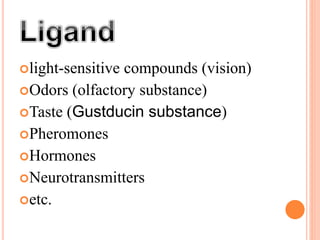The document provides an extensive overview of G-protein coupled receptors (GPCRs) and their signaling mechanisms, detailing the structure and function of various G-protein subunits (α, β, γ). It describes how GPCRs activate intracellular signaling pathways through the exchange of GDP for GTP, leading to effects such as modulation of ion channels and activation of downstream enzymes like adenylate cyclase and phospholipase C. Additionally, the document lists examples of ligands and physiological roles associated with different types of GPCRs and their corresponding G-protein subunits.



































